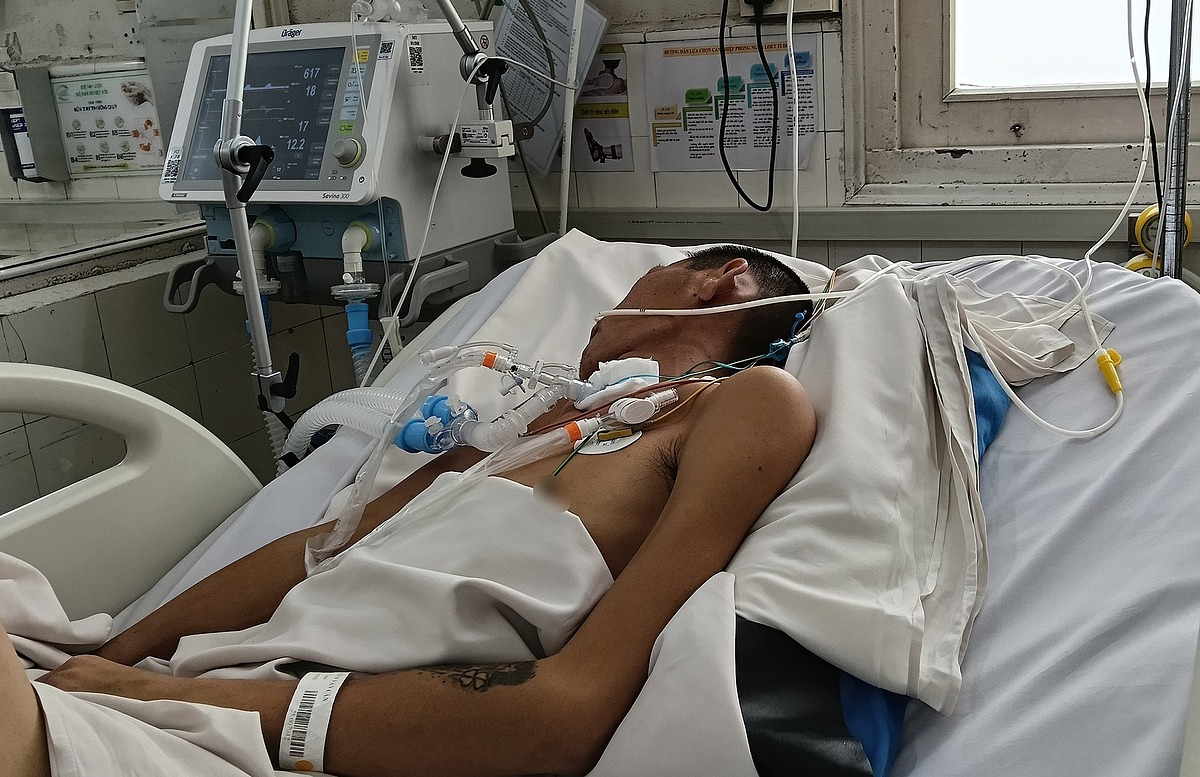On 20/7, Dr. Ho Dang Trung Nghia, head of the Viet Anh Infectious Diseases Department at the Ho Chi Minh City Hospital for Tropical Diseases, reported that the patient is conscious and can communicate with his eyes, but is completely paralyzed and dependent on a ventilator. His wife was pregnant when he first fell ill, and now, with a one-year-old child, he has yet to hold or speak to his baby.
"The patient is likely to face lifelong disability, with little chance of recovery," said Dr. Nghia.
The intensive care required for his treatment has been costly. From early 10/2023 to the present, his medical expenses have exceeded 1.7 billion VND. Insurance covered nearly 1.4 billion VND, leaving his family to manage over 330 million VND, a significant financial burden.
 |
After nearly two years of treatment at the Ho Chi Minh City Hospital for Tropical Diseases, the patient remains on a ventilator. *Photo: Hospital provided* |
Japanese encephalitis is a viral disease transmitted through the bite of infected Culex mosquitoes, which acquire the virus by feeding on infected wild birds and domesticated animals like pigs, cows, and horses. The virus enters the human bloodstream and attacks the brain, causing inflammation.
Initial symptoms include fever and headache, followed by confusion, muscle stiffness, convulsions, and coma. These are typical symptoms of encephalitis. Doctors confirm Japanese encephalitis through blood and cerebrospinal fluid tests.
The disease can affect people of any age, even those in good health. For every person who develops severe encephalitis and enters a coma, an estimated 400 people in the community may have asymptomatic infections. Approximately one in 400 to 850 infections result in neurological symptoms. In countries where Japanese encephalitis is prevalent, most infections occur in children under 15. In Vietnam, roughly 40% of childhood encephalitis cases are attributed to the Japanese encephalitis virus, with the 25-30 age group accounting for approximately 5% of cases.
Japanese encephalitis has a mortality rate of 20-30%. Among survivors, 30-50% experience severe complications such as mental disorders, paralysis, speech impairment, seizures, epilepsy, and long-term confinement to bed.
According to Dr. Nghia, at the Viet Anh Infectious Diseases Department, the mortality rate is around 10-20%, but the disability rate is as high as 70% because most patients arrive at the hospital in critical condition. The department is currently treating another patient, a 33-year-old from Ho Chi Minh City (formerly Binh Duong), who contracted Japanese encephalitis earlier this summer. After two months of treatment, this patient is off the ventilator but requires ongoing care due to severe debilitation, muscle atrophy, and hemiparesis (weakness on one side of the body).
In May, a male patient in his early twenties, who had recovered from Japanese encephalitis and been discharged, was re-admitted with fever and headache shortly after returning home. After tests failed to identify a cause, doctors diagnosed autoimmune encephalitis and transferred him to another facility for specialized treatment.
The disease places a heavy burden on patients, the healthcare system, and society. Treatment involves prolonged mechanical ventilation, with the risk of pneumonia, pressure sores, and the need for nutritional support and physical therapy. Many survivors experience long-term disabilities, impacting their ability to work and requiring ongoing care.
"The severe complications are a major concern for doctors treating patients with Japanese encephalitis," said Dr. Nghia.
There is no specific antiviral treatment for Japanese encephalitis. Vaccination is the most effective preventive measure. The Japanese encephalitis vaccine is part of Vietnam's Expanded Program on Immunization and is also available privately. Incomplete vaccination still carries a risk of severe complications. Therefore, reviewing vaccination records and ensuring complete vaccination, especially for children, is crucial for effective prevention.
Le Phuong












